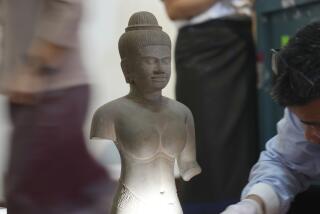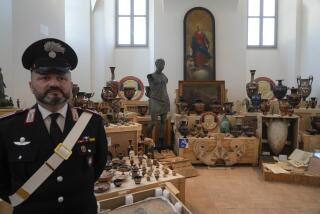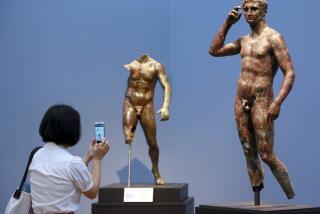Italy exhibits its recovered masterpieces
- Share via
ROME — Italian authorities Monday triumphantly unveiled an exhibition of dozens of ancient artworks returned by American museums in recent months, the symbolic conclusion of their decade-long campaign to repatriate objects looted from Italian soil.
The 68 antiquities on display at the Quirinale Palace include some of the most prized sculptures and vases purchased by the J. Paul Getty Museum, New York’s Metropolitan Museum of Art, the Boston Museum of Fine Arts and the Princeton University Museum of Art over the last 20 years, when many turned a blind eye to the illicit traffic in ancient art.
“The odyssey of these objects, which started with their brutal removal from the bowels of the earth, didn’t end on the shelf of some American museum,” said Francesco Rutelli, Italy’s vice prime minister and cultural minister, at the exhibit’s opening. “With nostalgia, they have returned. These beautiful pieces have reconquered their souls.”
Rutelli guided nearly 200 journalists through the exhibition’s dramatic venue, which dominates Rome’s highest hill and is considered the heart of the Italian state.
Lining the palazzo’s formal gallery were carefully lighted display cases containing objects that were once signature pieces of their American owners. The works include a towering marble statue of Vibia Sabina, a Roman empress, from the Boston museum and, from the Getty, the arresting sculpture of mythical griffons attacking a fallen doe. The Met’s famous vase, the Euphronios krater, will join the exhibition in January.
The exhibit is titled “Nostoi: Returned Masterpieces,” an allusion to a lost epic poem recounting the return of heroes from the Trojan War. It opens to the general public Friday and runs through May 2, free except on Sundays, when the entrance fee is $7.
Italy has not announced where the objects will go afterward, but many are expected to return to regional museums near where they are believed to have been illegally excavated. Officials said the insurance value for the exposition was $700 million.
For many Italians, the exhibit will be the first opportunity to see objects that have been the subject of legal battles and international press reports for years. The dispute over the Euphronios krater, for example, began shortly after the Met purchased it for $1 million in 1972.
The objects were returned after Italian investigators spent a decade uncovering evidence they had been looted from tombs and ruins, smuggled out of the country and trafficked by a network of dealers. The museums that purchased them have said they were unaware of their illicit origins.
Many of the objects are also part of the ongoing criminal trial in Rome of Marion True, the Getty’s former antiquities curator, and Robert Hecht, a prominent American antiquities dealer, both accused of conspiring to traffic in looted art. Both have denied the charges.
In a hearing Thursday, lawyers for Sicily and the Italian state followed through with their promise to drop civil charges against True. Her criminal trial, however, continues.
The court allowed into evidence documents first published in The Times that suggest True’s superiors at the Getty were long aware that they had bought objects looted from Italian soil.
At Monday’s event, Rutelli thanked the prosecutor in the True case, Paolo Ferri, whose investigative work created the basis for Italian claims against the Getty and other museums. But the focus of the statements by Italian officials was on the importance of the accords Italy has signed with the U.S. museums.
“There are agreements of cooperation, not simply of restitution,” explained Giuseppe Proietti, general director of the Italian Culture Ministry. “We are not here to count winners and losers.”
Italy has agreed to lend objects from its extensive state antiquities collections, and many American museums have pledged to change their acquisition practices.
--
Special correspondent Borghese reported from Rome and Times staff writer Felch from Los Angeles.
More to Read
The biggest entertainment stories
Get our big stories about Hollywood, film, television, music, arts, culture and more right in your inbox as soon as they publish.
You may occasionally receive promotional content from the Los Angeles Times.










